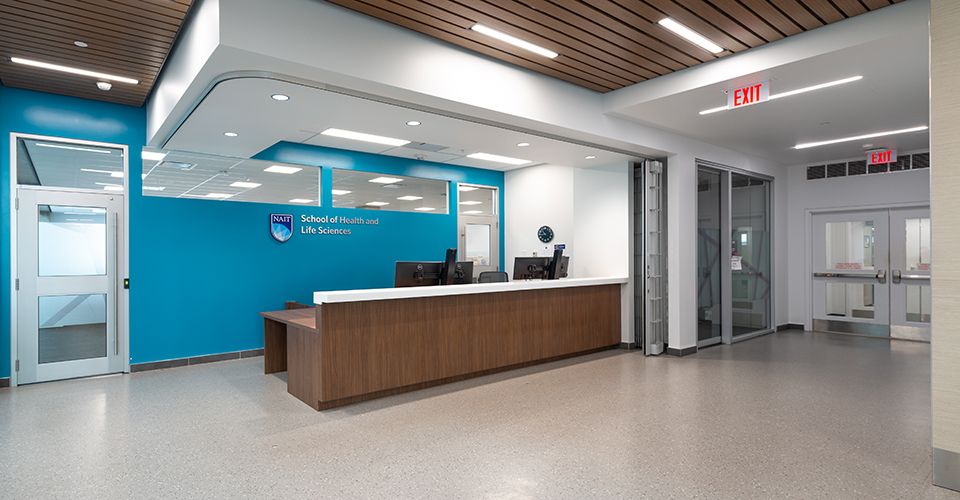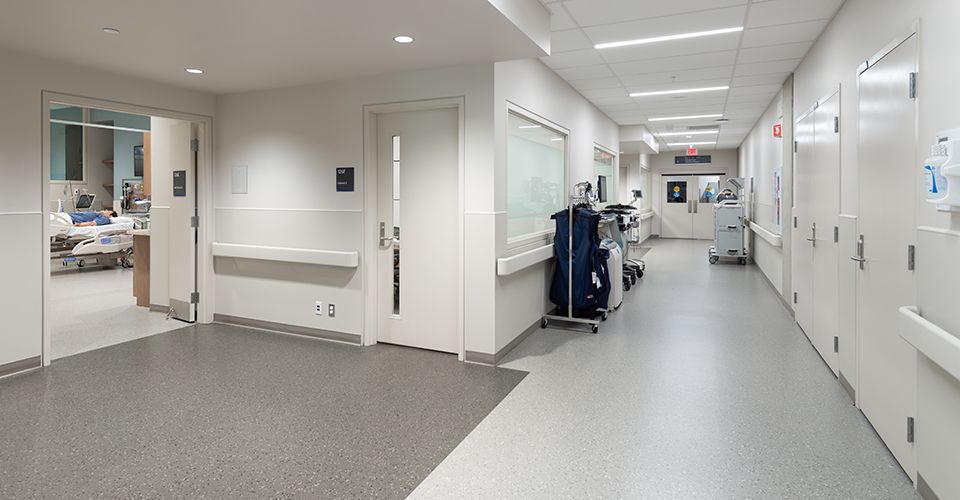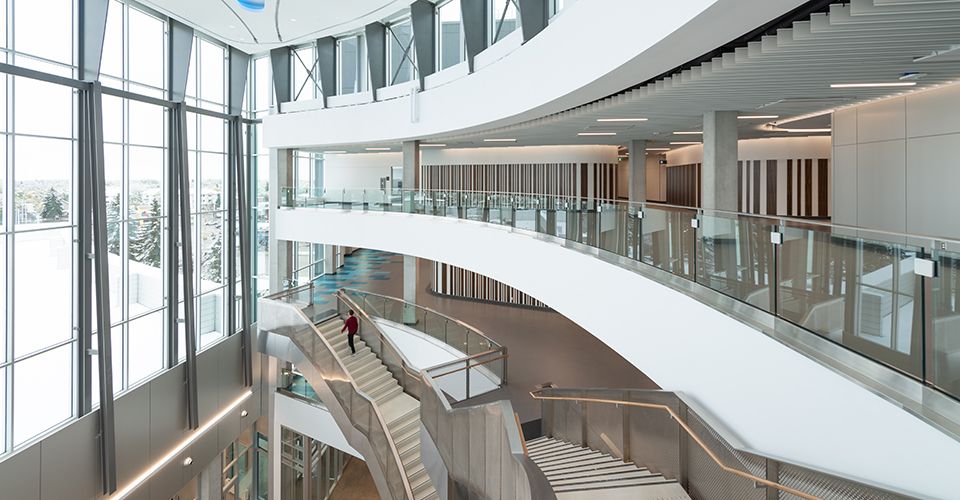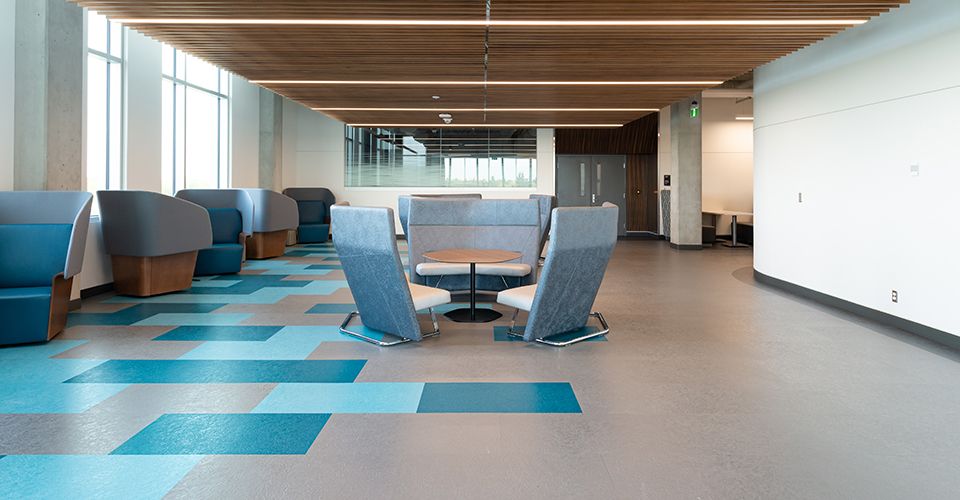As a leading polytechnic and one of Canada’s largest apprenticeship trainers, the Northern Alberta Institute of Technology (NAIT) offers world-class higher education that propels industry, innovation, and sustainability. NAIT’s campuses in Edmonton and Spruce Grove serve more than 50,000 students from across Canada and around the world.
With a concerted focus on applied sciences and technologies, health and life sciences, skilled trades, and business, NAIT’s main Edmonton campus includes three primary education facilities – the Centre for Applied Technology (CAT), the Productivity and Innovation Centre (PIC) and the HP Centre. These buildings are comprised of dynamic consequential spaces, including dozens of labs, advanced medical simulation rooms, and classrooms backed by nora® rubber flooring.
In 2009, Stantec began designing the Centre for Applied Technology (CAT), effectively the hub of campus, which would house over 5,000 individuals at any given time. The new building – equipped with classrooms, labs, a 135-seat lecture hall, a food court, and a five-story gathering space dubbed Main Street – is home to the School of Health and Life Sciences, the School of Business, and the School of Applied Sciences and Technology.
“The historical approach to higher ed design has been more of a one-size-fits-all standard,” said Sonja Dutra, Stantec’s lead interior designer for CAT. “Now, class is more of an exploratory learning environment that allows students to work in groups as most people will in their actual career.”
“One of the desired outcomes with CAT is to have our next generation of healthcare practitioners be job-ready,” said Graham Westbrook, the acting director for the Centre of Advanced Medical Simulations. “Everyone wants to know that the person who’s operating on their loved one is competent, but you don’t want them practicing on your mom or grandma. This is the center that provides a space that’s safe and low-consequence to train for that.”
Centre for Applied Technology (CAT), designed by Stantec
Centre for Applied Technology (CAT), designed by Stantec
Centre for Applied Technology (CAT), designed by Stantec
Creating a Built Environment to Support Experiential Learning
“Your space shapes you, and you shape the space,” said Leo Lejuene, principal, architecture sector lead, at Stantec. “In the case of higher education, it’s important that we create spaces where staff and students can be themselves and feel inspired to be their best.”
“Material selection is essential in higher ed settings as students come into contact with the materials firsthand,” said Carmen Williams, an Interior Design Specialist at Stantec. “You want the materials to be durable. You want them to be aesthetically pleasing. You don’t want facilities like this to feel so institutional.”
nora rubber was also chosen for the Productivity and Innovation Centre (PIC), which was designed by GEC Architecture. Composed of two wings joined by a central atrium designed for collaboration and hosting events, GEC Principal Peter Osbourne describes the two wings as hosting very different kinds of spaces. “One side is a bit noisier and messier with material and product testing labs, 3-D printing and more. The other is more technical in nature with lasers and electronics labs, drone labs, classrooms and a large conferencing area, places that must stay clean.”
While concrete is the flooring for the messier lab areas, GEC selected nora rubber flooring in the more sensitive spaces for its durability, ease of maintenance and aesthetics. Osborne says, “One of the reasons we used it is the durability. It’s installed throughout the more public spaces in the building, including the main public corridors, as well as the computer training rooms and more sensitive areas. The ability to keep it clean, especially in research spaces, was also a big factor.”
GEC used standard nora colorways to represent the school’s brand and to define areas within the space. Osborne explains, “Part of the building’s aesthetic is around the institution’s brand, which has a blue in it. So, at the ends of the corridors we introduced the blue accent in two or three different colors from the same product line, which defined seating areas while fading in color.”
“One other thing we personally liked about the product is that it’s textured,” continues Osborne. “So, it wasn’t a flat surface. It helps with slip resistance, of course, but it also just has a really nice feel to it. That kind of texture really adds a lot of character to the floor.”
Productivity and Innovation Centre (PIC), designed by GEC Architecture
Productivity and Innovation Centre (PIC), designed by GEC Architecture
Building a Main Street to Encourage Community
Like the PIC building, the five-story atrium at the center of CAT serves a variety of purposes, such as a meeting area, career fair location, etc. For this “Main Street” area to support the expected volume of students occupying and traversing the space, acoustics were a considerable concern in selecting building materials for the project.
“Acoustics in such a large atrium are naturally a challenge,” Dutra said. “The flooring has to minimize the sound that travels around the space.”
As students, faculty and staff move away from Main Street, nora rubber flooring contributes to helpful wayfinding, delineating classroom space through the use of contrasting colors.
“We created little alcoves with hits of color throughout the very long hallways that marked an entrance to a classroom,” Lejuene said. “We have these colorful pockets of magenta, turquoise and orange with a bench for students to utilize after class for a quick meeting with their instructor.”
Supporting Student Outcomes Through Flooring
Edmonton sees almost nine months of snow a year, which is treated with gravel and sand. This extreme weather warrants the most durable of materials. NAIT expected to see the effects of snow in the hallways and communal areas. However, nora’s premium rubber flooring is wear-resistant, providing a cost-efficient flooring solution that lasts for decades.
The extremely dense, nonporous surface entirely eliminates the need for waxes or coatings and easily repels liquids and dirt, making cleaning very simple. Additionally, the benefits associated with modular flooring were a significant draw in selecting nora. “All you have to do is lift one tile, if it’s damaged, and replace it. There is minimal disruption to the area around it, and the costs stay low,” Williams said.
For the experiential learning spaces, especially healthcare related, a simplified cleaning procedure is particularly beneficial. Similarly, the flooring must be slip-resistant to minimize safety concerns.
“We use a lot of simulated blood made with food coloring and water as well as actual theater-type blood,” Westbrook said. “It’s easy to clean the floors, and the ability to mop it up quickly really helps us keep going through the day. We have safety orientations to ensure we’re quickly cleaning up any mess and restoring the flooring.”
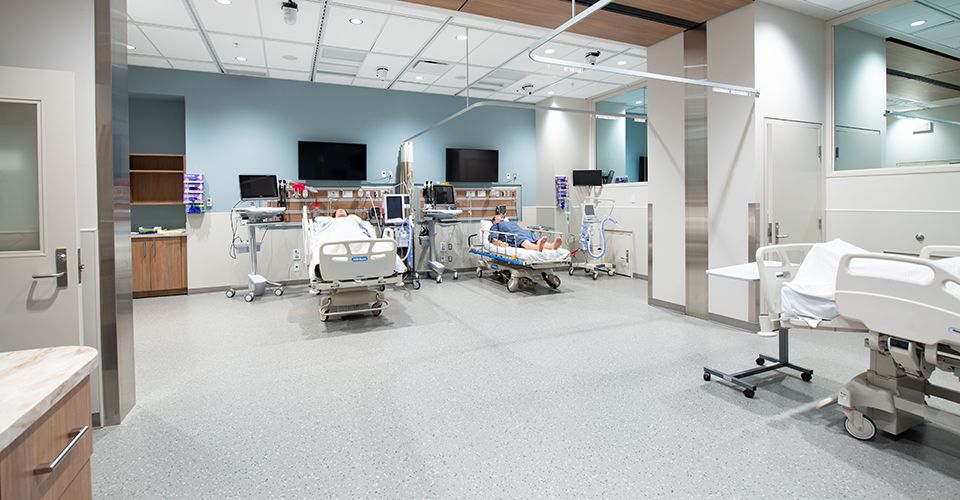
Centre for Applied Technology (CAT), designed by Stantec
Extending Benefits Beyond the NAIT Walls
NAIT selected nora rubber flooring for its sustainability benefits – all nora rubber sheets and tiles are carbon neutral across their entire product lifecycle.
“Sustainability is really important when we select materials,” Williams said. “We want to make sure they have low VOCs and can be reused. We want to be environmentally conscious and select materials with recycled content.”
“Our goal was to achieve LEED Silver,” Lejuene said. “But, as construction started drawing to a close, we realized we were garnering more points for recycled content and waste diversion than initially planned. In the end, we were able to achieve LEED Gold.”
